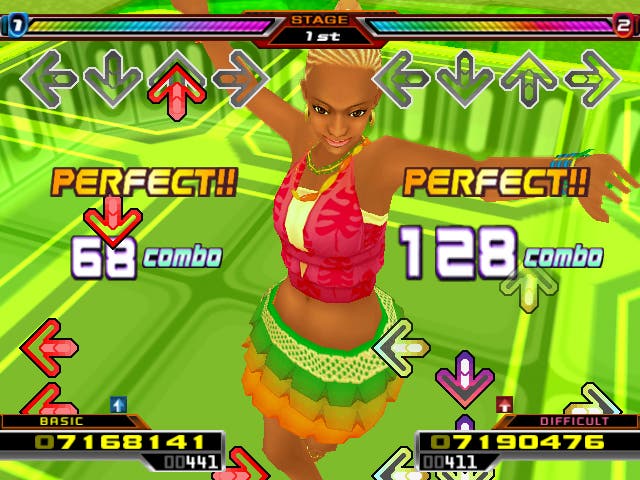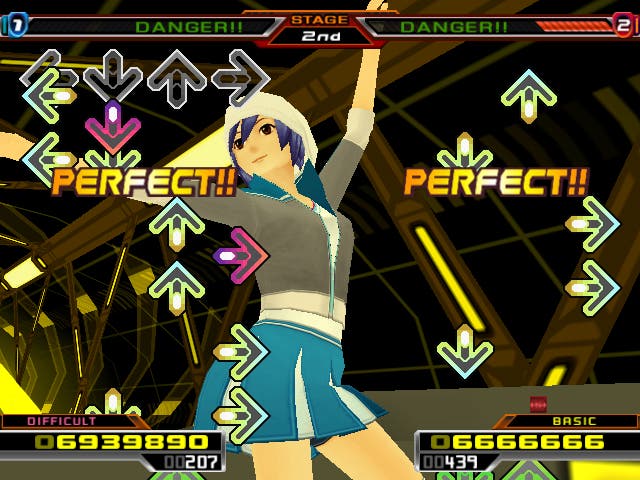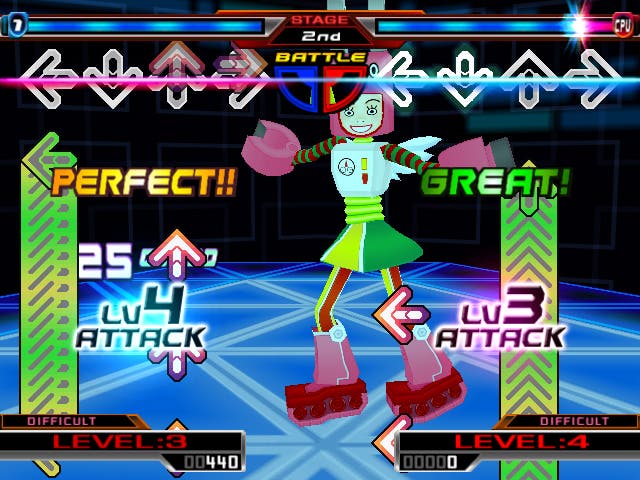Dancing Stage SuperNOVA
Public humiliation goes private.
Given that the series has been going for the past eight years or so, you've probably long since made your mind up about DDR (or Dancing Stage, as killjoys Konami insist on calling Dance Dance Revolution in Europe). For some, prancing around on a dance mat has become not only a favoured gaming experience, but also an important social outlet. Entire communities have sprung up around the DDR scene, and the machines can still draw huge crowds of teenagers in the arcades and bowling alleys in which they're found.
For others, the idea of hopping up onto the square plastic mat of a DDR machine and publicly humiliating yourself by stamping along to a painfully up-tempo Japanese Eurobeat dance mix is... Well, let's just say that if we assume that there is a hell, there are definitely people who will find Lucifer himself down there grimly feeding an endless supply of 50p coins into a DDR machine for them.
The home versions of the game, however, provide an interesting middle ground. They do suffer from being played, for the most part, on flexible vinyl mats which can slide around the floor and generally be a bit rubbish. On the other hand, you get to practice your steps, work up a bit of a sweat and even secretly enjoy the music (go on, admit it) in the privacy of your own living room.
Twinkle Toes
Dancing Stage SuperNOVA is only the latest in a fairly long series of DDR titles for the PS2, and it is, unsurprisingly, a port of the Dancing Stage SuperNOVA game which appeared at the arcades last April. However, it's far from an exact port; for a start, it contains significantly fewer songs. The arcade system boasted over 300 tracks, while the home version, presumably simply due to space considerations, has well under 100 songs. We don't know the exact figure, since loads of them are locked away behind achievements which we haven't quite managed yet, but it looks like there are around 70 tracks in the game. It's still a good number, but if you were a big fan of the arcade original, you may well find some tracks you like missing from the home edition.

More importantly, though, the game has been changed in a number of significant ways to make it more friendly and enjoyable for home play - and, crucially, for single-player. DDR has always been a social experience, and for players who have mastered the basics of the game, it's an excellent competitive experience - but it would be more than fair to say that it's always been a little weak for a solo player.
Nothing about the fundamentals of DDR has changed, of course. At the heart of the game, you still have arrow symbols which rise up the screen, and when they reach the top, you need to stamp your feet on the appropriate part of the dance mat. The trick, of course, is that certain groups of symbols can only be hit by learning specific dance "moves", so the game becomes a task of pattern recognition - and, naturally, quick reactions. Konami's developers are extremely practised at the task of setting up solid, well-considered challenges in this regard, and matching those dancing challenges to the songs in the game; Dancing Stage SuperNOVA is as good as anything the company has ever created in that respect.
The home versions of DDR are all focused on the window dressing around that core dancing mechanic. Many of the modes in SuperNOVA will be easily recognisable to those who have played previous home versions of DDR - the calorie counting mode, for example, which allows you to enter your present weight and a target weight, and then burn off the fat with some fairly intensive dancing workouts. Modes like this simply work, and they're an important part of the game, so while they have been tweaked and marginally improved, by and large Konami has chosen not to fix what wasn't broken.
The big addition, then, is what's called Stellar Master Mode. Essentially, this is a mission-based singleplayer, which sees you travelling between various planets and completing challenges there. The objectives start off simple enough even for club footed lummoxes like us, but rapidly scale up to provide ample challenge for any DDR player. Some are very simple - completing three songs, say, or beating a song with a particular ranking or above. Others, marked out as boss battles, are more complex and interesting; challenges asking you to dance a section of a song without the music turn out to be surprisingly tricky.
Strictly Bum Prancing

It's definitely a more interesting approach than the traditional DDR progression of playing through loads of songs to accumulate points and unlock content - although that's still open to you, if the Stellar mode doesn't grab you. Although it's a new addition to the series, it's a fairly strong and well-integrated mode - much more so than the Eye Toy functionality, which continues to feel tacked on and doesn't integrate well with the dancing modes in the game.
Unless this functionality can be massively improved, the only real use we can see for Eye Toy in DDR would be the ability to play online with streaming video of your opponent, but this isn't supported (actually, that could be a blessing). As it stands, although the Eye Toy logo appears prominently on the game, we didn't actually spend very much time at all with this mode. It's not a massive down-side, though, because the core game remains intact - but it's not something we'd recommend the game on the strength of, either.
We have to confess that we're also in two minds about the song listing for the game. Konami seems determined to include western pop hits and classics in DDR releases in this part of the world - and while we understand the logic in terms of opening the game up to a wider audience, we're less convinced by how some of those songs actually work as dance tracks. Where its original DDR releases had tracks selected for their strength in terms of gameplay, SuperNOVA has several tracks which seem to have been selected for popularity - with dancing tagged on to them after the fact.

This may, of course, be a matter of personal preference - and some players may actively prefer the pop-style tracks, which are slower and a bit more deliberate than the Eurobeat madness. As with Singstar titles, we're going to have to fall back on suggesting that you check out the track listing, and working out to your own satisfaction whether the song list appeals to your tastes.
The other concern, of course, is that while DDR may be the grandfather of games which get you to work up a sweat, it's hardly alone in this field any more. In a post-EyeToy, post-Wii world, the idea of really physical gameplay is no longer a novelty - and the subtlety of controls in good Wii games does show up DDR as a bit of a dinosaur in some regards. It is, at the end of the day, more about stomping than about dancing; it's simply not remotely as varied as players who have been lucky enough to actually get their hands on a Wii will be used to.
Dancing Stage SuperNOVA's new singleplayer mode is a nice addition, but it's a minor innovation in the scale of things. While this remains a great multiplayer, social game for some people, and it's certainly a good way to work up a sweat, at heart it's still an eight year old game with remarkably little alteration from the original. For long-time DDR fans, of course, this simply doesn't matter - but it's certainly a consideration for everyone else. SuperNOVA is still a solid game in the context of the franchise, but Konami needs to be thinking hard about where the franchise as a whole is going to go in the coming years, because there's nothing here that would drag in new players to the world of DDR.

